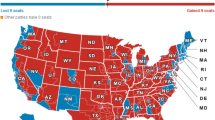Abstract
We propose the use of self-organizing maps as models of social processes, in particular, of electoral preferences. In some voting districts patterns of electoral preferences emerge, such that in nearby areas citizens tend to vote for the same candidate whereas in geographically distant areas the most voted candidate is that whose political position is distant to the latter. Those patterns are similar to the spatial structure achieved by self-organizing maps. This model is able to achieve spatial order from disorder by forming a topographic map of the external field, identified with advertising from the media. Here individuals are represented in two spaces: a static geographical location, and a dynamic political position. The modification of the later leads to a pattern in which both spaces are correlated.
Access this chapter
Tax calculation will be finalised at checkout
Purchases are for personal use only
Preview
Unable to display preview. Download preview PDF.
Similar content being viewed by others
References
Kohonen, T.: Self-Organizing maps, 3rd edn. Springer, Heidelberg (2000)
Barreto, G., Araujo, A.: Identification and control of dynamical using the self-organizing map. IEEE Transactions on Neural Networks 15(5), 1244–1259 (2004)
Galam, S.: The dynamics of minority opinions in democratic debates. Physica A 336, 46–62 (2004), doi:10.1016/j.physa.2004.01.010
Pabjan, B., Pekalski, A.: Model opinion forming and voting. Physica A 387, 6183–6189 (2008), doi:10.1016/j.physa.2008.07.003
Costa, R., Almeida, M., Andrade, S., Moreira, M.: Scaling behavior in a proportional voting process. Phys. Rev. E. 60, 1067–1068 (1999)
Tuncay, C.: Opinion Dynamics Driven by Leaders, Media, Viruses and Worms. Int. J. of Modern Physics C 18(5), 849–859 (2007)
González-Avella, J., Cosenza, M., Tucci, K.: Nonequilibrium transition induced by mass media in a model for social influence. Phys. Rev. E 72 (2005)
Mazzitello, K., Candia, J., Dossetti, V.: Effects of Mass Media and Cultural Drift in a Model for Social Influence. Int. J. Mod. Phys. C 18, 1475 (2007)
Villmann, T., Der, R., Herrmann, M., Martinetz, T.: Topology preservation in self-organizing feature maps. IEEE Tr. on NN. 8(2), 256–266 (1997)
Flanagan, J.: Sufficiente conditions for self-organization in the SOM with a decreasing neighborhood function of any width. C. of Art. NN. Conf. pub. 470 (1999)
Erwin, E., Obermayer, K., Schulten, K.: Self-organizing maps: Ordering, convergence properties and energy functions. Biol. Cyb. 67, 47–55 (1992)
Erwin, E., Obermayer, K., Schulten, K.: self-organizing maps: stationary states, metastability and convergence rate. Biol. Cyb. 67, 35–45 (1992b)
Niemelä, P., Honkela, T.: Analysis of parliamentary election results and socio-economic situation using self-organizing map. In: Príncipe, J.C., Miikkulainen, R. (eds.) WSOM 2009. LNCS, vol. 5629, pp. 209–218. Springer, Heidelberg (2009)
Schelling, T.: Micromotives and Macrobehavior. W. W. Norton (1978)
Axelrod, R.: The dissemination of culture. J. of Confl. Res. 41, 203–226 (1997)
Schulz, R., Reggia, J.: Temporally Asymmetric Learning Supports Sequence Processing in Multi-Winner Self-Organizing Maps. Neural Comp. 16(3), 535–561 (2004)
Flanagan, J.: Self-organization in the one-dimensional SOM with a decreasing neighborhood. Neural Networks 14(10), 1405–1417 (2001)
Celluci, C., Albano, A., Rap, P.: Statistical validation of mutual information calculations. Phys. Rev. E 71, 66208 (2005)
Author information
Authors and Affiliations
Editor information
Editors and Affiliations
Rights and permissions
Copyright information
© 2011 Springer-Verlag Berlin Heidelberg
About this paper
Cite this paper
Neme, A., Hernández, S., Neme, O. (2011). Self Organizing Maps as Models of Social Processes: The Case of Electoral Preferences. In: Laaksonen, J., Honkela, T. (eds) Advances in Self-Organizing Maps. WSOM 2011. Lecture Notes in Computer Science, vol 6731. Springer, Berlin, Heidelberg. https://doi.org/10.1007/978-3-642-21566-7_5
Download citation
DOI: https://doi.org/10.1007/978-3-642-21566-7_5
Publisher Name: Springer, Berlin, Heidelberg
Print ISBN: 978-3-642-21565-0
Online ISBN: 978-3-642-21566-7
eBook Packages: Computer ScienceComputer Science (R0)




